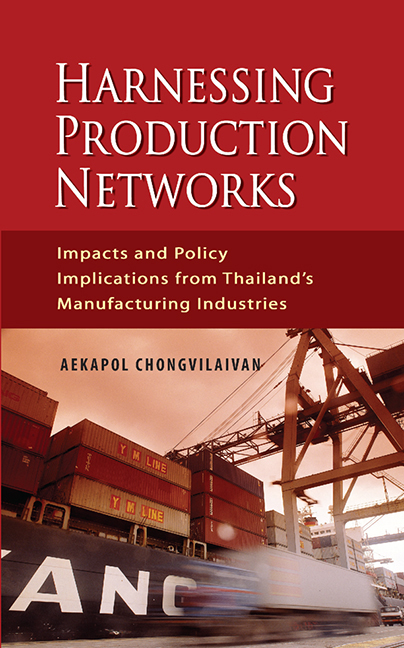 Harnessing Production Networks
Harnessing Production Networks Book contents
- Frontmatter
- Contents
- List of Tables and Figures
- Acknowledgements
- 1 Introduction
- 2 Characteristics of Firms in Thailand's Manufacturing Sector
- 3 Firm Productivity Effects
- 4 Labour Productivity Effects
- 5 Skills Upgrading: Winners or Losers?
- 6 Outsourcing Typology: Does It Matter?
- 7 Policy Implications
- Bibliography
- Index
- About the Author
4 - Labour Productivity Effects
Published online by Cambridge University Press: 21 October 2015
- Frontmatter
- Contents
- List of Tables and Figures
- Acknowledgements
- 1 Introduction
- 2 Characteristics of Firms in Thailand's Manufacturing Sector
- 3 Firm Productivity Effects
- 4 Labour Productivity Effects
- 5 Skills Upgrading: Winners or Losers?
- 6 Outsourcing Typology: Does It Matter?
- 7 Policy Implications
- Bibliography
- Index
- About the Author
Summary
Introduction
The past few decades witnessed a remarkable increase in production fragmentation and outsourcing activities in the world (Abraham and Taylor 1996; and Díaz-Mora 2007). The dominance of outsourcing which has become part and parcel of business practices is attributed to persistent plunges in transaction costs as a consequence of the prevalent uses of the information and transportation technology and trimmed trade barriers. The lack of intuitive understandings of its impacts on domestic labour markets gives rise to an exploding number of studies that inquire one of the main research questions in the literature — how does outsourcing elicit changes in labour productivity? The production theory suggests that outsourcing may be beneficial for productivity of labour employed in-house in at least two ways (Amiti and Wei 2009). First, the decision to outsource intermediate inputs is concerned with compositional changes. Fragmented stages of production allow a firm to contract out non-core production activities and reallocate the existing labour to core-competent activities. As workers become more concentrated on and/or specialized in the activities in which a firm possesses comparative advantage, one would expect higher productivity and performance workers can exert. Furthermore, outsourcing also results in structural changes — an outsourcing firm tends to have advantages over an integrated firm in terms of the superior access to a cheaper pool, more variety and higher quality of intermediate inputs. These structural improvements ultimately enable labour to materialize higher productivity via learning.
Using Thailand's establishment-level data, the present chapter empirically investigates the impacts of outsourcing on labour productivity, measured by output per worker. My empirical estimates reveal that outsourcing contributes to labour productivity growth in Thailand's manufacturing industries and hence are rather consistent with the findings by previous research, including Görzig and Stephan (2002), Egger and Egger (2006), and Amiti and Wei (2009), among many others. I also attempt to account for two establishment-specific characteristics — outsourcing locations and foreign ownership. The extension confirms the findings by Chongvilaivan and Hur (2011) that the effects of outsourcing on labour productivity are more pronounced for an establishment that pertains to international outsourcing, and therefore sheds further light on the crucial roles of outsourcing locations in explaining a shift in labour productivity.
Information
- Type
- Chapter
- Information
- Harnessing Production NetworksImpacts and Policy Implications from Thailand's Manufacturing Industries, pp. 52 - 73Publisher: ISEAS–Yusof Ishak InstitutePrint publication year: 2011